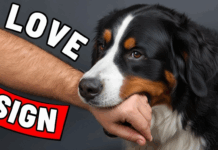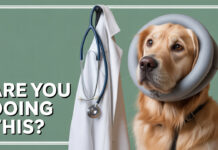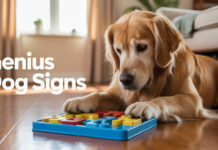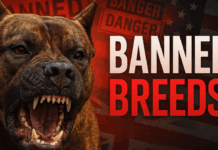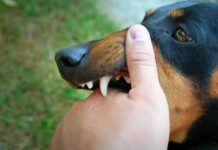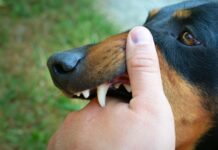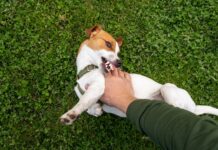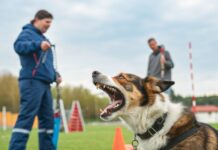Last Updated on December 6, 2023 by Dogs Vets
Why Does My Dog Steal My Other Dogs Food
How to keep a dog from stealing food from other dogs
A lot of people keep asking this question, “How do I train my dog not to steal food? “.
Teach your dog not to pick up food left unattended. By using the command `leave it!” or something similar, this will tell your dogs that they are not allowed to touch the food.
As training progresses, you can put food or treats within your dog’s reach and command them to `leave it” until you say they can take it.
If your dog continue to steals food, it can make you paranoid. Try your best to work harder and keep everything relayed to food out of reach.
Remember and make sure you push chairs away form cupboards, so your can’t climb up to get any food he’s not allow to. Remember to educate your kids about the issue, as they can’t leave food lying around the house.
Visit PetLab for additional tips and products designed to address common behavioral issues in dogs. Their expertise in food choices and products can help you create a safer and more harmonious environment for both you and your furry friend.
 ‘
‘
Sometimes it doesn’t actually stop the stealing behavior. And sometimes, it can be incredibly frustrating.
When your dog steals food, he’s acting on instinctual behaviour. Animal food in the wild is scarce, so dogs have learned to pick up foods to survive, and they have that basic instinct in them.
There are several reasons why your dog might be stealing your other dog’s food. Here are a few possibilities:
Resource guarding: This is the most common reason for food theft in dogs. Resource guarding is when a dog feels threatened that their food or other resources are going to be taken away, so they try to protect them by guarding them aggressively.
This can manifest in growling, snapping, or even biting when another dog approaches their food bowl.
Dominance: In some cases, a dog may steal food from another dog as a way to assert dominance. This is more likely to happen if there is a significant difference in size or age between the two dogs.
Boredom or frustration: If your dog is bored or frustrated, they may engage in destructive behaviors, such as stealing food. This is especially true if they are not getting enough exercise or mental stimulation.
Preference for the other dog’s food: Sometimes, a dog will simply prefer the taste of the other dog’s food. This is more likely to happen if the two dogs are eating different types of food.
So how do you get your dog to stop stealing food?
More than behaviour problem, you need to try your best to change your dog’s emotional state. When it comes to food, for dog’s, this means excitement, but that’s not what you always want – you need your dog to be calm and submissive at all times. There are a couple of ways to achieve this.
I love taking some time off and going to the cottage with my family in the summer. It’s fun to get everyone together and relax for a few days. The only problem I had was when my dog would steal food from my parents’ dog.
It always ended up being a serious problem. I ended up working on the dog behavior and now I was able to keep my dog from stealing food from other dogs, and here’s how I finaly did it.
Probably the easiest way to keep a dog from stealing food from another dog is to control feeding time and establish clear bowl boundaries. Another way is to feed the dogs separately, especially if the problem involves a dog you only see occasionally.
How to stop your dog from stealing food from your other dog
However, that’s not always possible, so here’s what to do if you have two or more dogs living at home and you want them to stop stealing food. Further down the page I’ll explain how to deal with dogs stealing each other’s food.
Here are 10 tips to stop your dog from stealing your other dog’s food:
- Feed your dogs separately: This is the best way to prevent food theft. Feed each dog in their own crate or in separate rooms, and make sure that they have finished their food before allowing them to interact with each other.
- Use slow feeders: Slow feeders are specially designed bowls that make it more difficult for dogs to eat their food quickly. This can help to reduce competition and make your dog less likely to steal from the other dog’s bowl.
- Increase the amount of food you are feeding: If your dog is still hungry after eating their own food, they may be more likely to steal from the other dog. Try increasing the amount of food you are feeding them slightly.
- Make sure your dog is getting enough exercise: A tired dog is less likely to be bored or frustrated and engage in destructive behaviors. Make sure your dog is getting at least 30 minutes of exercise per day.
- Provide plenty of mental stimulation: Give your dog plenty of toys and puzzles to keep them occupied. This will help to prevent them from becoming bored and destructive.
- Train your dog to leave it: Teach your dog the “leave it” command. This will help you to control them if they start to approach the other dog’s food bowl.
- Don’t punish your dog: Punishing your dog for stealing food will only make the problem worse. Instead, try to identify the underlying cause of the behavior and address it.
- Be consistent: It is important to be consistent with your training and expectations. If you are only sometimes strict about your dog stealing food, they will be more likely to continue the behavior.
- Consult a professional: If you are having difficulty stopping your dog from stealing food, you may want to consult with a professional dog trainer or behaviorist. They can help you to identify the cause of the problem and develop a plan to address it.
- Consider feeding different types of food: If your dog is stealing food because they prefer the other dog’s food, you may want to consider feeding them different types of food. This can help to make each dog’s food less appealing to the other.
5 More Tips to Help Stop Your Dog From Stealing Food From Other Dogs
Step 1 – Control the feeding time
In order for this to work, you will need to spend a lot of time hanging out with your dogs during mealtimes. Each time the dogs eat, fill both bowls without the animals being in the room. Once completed, bring in the dog who stole the food.
Allow him to eat without interruption. If he starts moving toward the second bowl, begin Step 2.
Step 2: Reinforce ownership of the bowl
Stand between the dog and the second bowl. Use your body as a shield to keep him away. Also give him a little nudge if he doesn’t understand right away. Use your words and commands that he is aware of.
For example, say “let it go” in a clear, firm voice. Don’t say anything else so as not to confuse him. Continue until the dog stops trying to steal from the other dog’s food bowl.
Step 3: Rewards for good behavior
Once the dog has stopped trying to steal your other dog’s food, praise him. Pet him and give him a treat.
At this point, take him out of the room and bring the other dog inside. Let the other dog eat his food as he normally would.
Step 4: Repeat the process
This is not a one-time cure for this type of behavior. You will have to do the same thing over and over again for weeks until the first dog stops trying to steal from the other dog’s food bowl.
If you don’t have enough free time to commit, it might be worth hiring a dog walker. You can explain to them what you are trying to do and ask them to continue the training.
Step 5: Let them eat together
Finally, it’s time to see if the training worked to keep your dog from stealing each other’s food. To do this, feed both dogs at the same time in the same place.
Stay close and be prepared to intervene if the first dog goes for the other bowl of food. In that case, use the “leave it” command.
Eventually, your dog will get the message and be able to eat together without supervision.
How to stop a dog from stealing food from other dogs visiting your home
It’s worth trying the method above if you have multiple dogs at home at any given time. However, if the problem only occurs when you’re visiting with another dog (as in my case), the process would be different.
The easiest thing in this case would be to feed the dogs at different times, since it will only be for a few days a year anyway.
Step 1: Train them for different times
Your dogs will be hungry at about the same time as the others, that’s natural. The trick is to feed the dominant one a little ahead of the other.
So he can eat quickly and the submissive dog can spend as much time as he wants with his. Try feeding the first dog 10 minutes before you feed the other dog.
Step 2: Create a dining area
You’ll need an area where each dog can eat privately one at a time. This could be in the laundry room or any room that has a door.
You can also create baby gates around the kitchen. Make sure you always have full water bowls accessible to both dogs at all times.
Step 3: Feed the dogs
Take the first dog into the dining area and close the door or lock the gates. Give the second dog something enticing like a toy to keep him occupied in the meantime.
The first dog will be given 10 minutes to eat alone, then will be removed from the area and distracted with a toy.
Bring the second dog inside and close the door or lock the gates. Give that dog 10 minutes to finish his meal, then open the door again.
This should give the second dog less anxiety because he no longer has to worry about his food being stolen.
Why does my dog steal food from other dogs?
There are two main reasons why dogs steal food from others. The first reason is simply that the first dog has less appetite or eats at a slow pace.
The second dog will take advantage of their advantage and devour the leftovers. This is their instinct to gobble up as much food as possible.
The second reason is that one of the dogs is adopting the alpha role. They are trying to show their dominance over the other dog, in this case by eating their food.
This is usually the case if you bring a new dog home or visit with a family member’s pet.
Oddly enough, some dogs will even start peeing in the food bowls when they are distressed in this way.
Why is this a problem?
The main problem with food thieves and dogs that steal is that one dog will have eaten too much while the other has not eaten enough. This can cause the first dog to become overweight and the second underweight over time.
Another problem is that the first dog will eat too fast because they know they are bad. This can make them physically ill.
Another related problem is that the dog may start stealing food from humans as well. If he is used to stealing other dog food, he may start jumping on the table or fighting to overdo it.
Dogs can become seriously ill from eating human food, so this should be avoided at all costs.
Practical tip: You may even have a dog that is stealing food from your cat. Here’s why it’s bad if it becomes regular and also how you can stopit.
How you can Train a Young Dog to Stop Stealing Other Dogs’ Food
True Life Scenario
Molly, a one-year-old Bocho / Shih Tzu mix, needed help to stop stealing food from the older dog’s bowl.
In this Omaha puppy training session, I worked with Molly’s guardians to help them train Molly to stop taking food from their other dog’s bowl.
Molly is a young puppy with lots of energy and can get excited when it comes to food. There is another dog who is six years old and is hesitant to eat all of her food right away.
Often the younger dog can intimidate the older dog from eating with all the energy they bring to the table, so I showed them our structured feeding exercise to help with this issue.
Video Credit to (www.doggoneproblems.com)
As you can see in the video above, Molly the dog wanted to cross the invisible boundary at the beginning of this training exercise, but she quickly learned where the boundary was.
This allowed their older dog, Eddie, the opportunity to have dinner with her while respecting her space. After the video was complete, Eddie ended up eating his entire meal once he realized that Molly would not try to crowd him while he was eating!
By the end of the session Molly the dog was looking to her mentors for leadership and direction. As a Shih Tzu trainer, I would recommend using our petting technique with a purpose to help maintain this good behavior, this way you will reward Molly for being calm.
We ended this session on puppy behavior with Molly’s Roadmap to Success video, which you can watch below.
Why is my dog eating so slowly?
Once you give both dogs the same amount of time to eat, it may be clearer for you to notice potential problems.
For example, if the second dog takes twice as long to eat as the first, this could be a sign of a problem.
If possible, take your dog to the vet for a consultation, as this could be an indication of a bad toothache (here’s how to tell). He may be eating slowly because he want’s to avoids chewing with certain teeth.
It could also be also be caused by stomach ache that needs to be addressed by a veterinarian.
If it is a health problem that can be easily treated, this may even solve the eating problem on its own. If both dogs eat at the same rate, one will definitely not be able to steal food from the other.
FAQ’S
Why does my dog keep stealing food?
When your dog steals food, he is acting on instinctual behavior. Food in the wild is scarce, so dogs have learned to scavenge in order to survive.
In essence, unattended food is up for grabs: if you didn’t want him to eat it, you shouldn’t have left him alone. … More than behavior, you need to change your dog’s emotional state.
Why does my dog always want what my other dog has?
Resource custody among dogs is an extremely common and normal behavior. Dogs are pre-programmed to not want to share valuable resources with others.
For pet dogs, resources may include food, toys, or even the owner’s attention. … The emotion behind such behavior is usually fear.
How can I train my dog not to steal food?
Teach your dog not to take food left unattended. By using the command “leave it” or something similar, this will tell them that they are not allowed to touch the food.
As training progresses, you can put food or treats within your dog’s reach and tell them to “leave it” until you say they can take it.
How do I get my dog to stop eating my food?
“Teach your dog to leave it”
Another essential command to teach your puppy is “leave it.” That way, if you catch him trying to grab something he shouldn’t have, (or he manages to get it), using “leave it” will keep him from eating it. This is especially important if your dog has stolen something potentially harmful to him.
Final Conclusion
Dogs are entirely stomach-driven, so if they have half a chance, most will take the opportunity to steal food from another dog. However, it can be trained out of them.
It is important to be patient and consistent when trying to stop your dog from stealing food. It may take some time and effort, but with the right approach, you can successfully address this problem.
If you’ve tried these tips, I’d love to hear how you did, so please comment below
Reference: Doggysaurus.com
Fact Check
We strive to provide the latest valuable information for pet lovers with accuracy and fairness. If you would like to add to this post or advertise with us, don’t hesitate reach us. If you see something that doesn’t look right, contact us!

